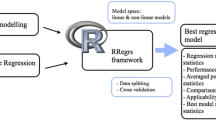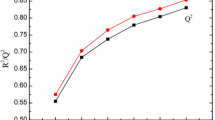Abstract
Two QSAR models have been identified that predict the affinity and selectivity of arylpiperazinyl derivatives for α1 and α2 adrenoceptors (ARs). The models have been specified and validated using 108 compounds whose structures and inhibition constants (K i) are available in the literature [Barbaro et al., J. Med. Chem., 44 (2001) 2118; Betti et al., J. Med. Chem., 45 (2002) 3603; Barbaro et al., Bioorg. Med. Chem., 10 (2002) 361; Betti et al., J. Med. Chem., 46 (2003) 3555]. One hundred and forty-seven predictors have been calculated using the Cerius 2 software available from Accelrys. This set of variables exhibited redundancy and severe multicollinearity, which had to be identified and removed as appropriate in order to obtain robust regression models free of inflated errors for the β estimates – so-called bouncing βs. Those predictors that contained information relevant to the α2 response were identified on the basis of their pairwise linear correlations with affinity (−log K i) for α2 adrenoceptors; the remaining variables were discarded. Subsequent variable selection made use of Factor Analysis (FA) and Unsupervised Variable Selection (UzFS). The data was divided into test and training sets using cluster analysis. These two sets were characterised by similar and consistent distributions of compounds in a high dimensional, but relevant predictor space. Multiple regression was then used to determine a subset of predictors from which to determine QSAR models for affinity to α2-ARs. Two multivariate procedures, Continuum Regression (the Portsmouth formulation) and Canonical Correlation Analysis (CCA), have been used to specify models for affinity and selectivity, respectively. Reasonable predictions were obtained using these in silico screening tools.
Similar content being viewed by others
Abbreviations
- AR:
-
adrenoceptors
- CCA:
-
Canonical Correlation Analysis
- cnvf :
-
canonical variate first set
- cnvs :
-
canonical variate second set
- C i :
-
the ith component
- CR:
-
Continuum Regression
- GPCR:
-
G-protein coupled receptors
- −log K i :
-
log transformed affinity
- 3H:
-
tritiated
- UFS:
-
Unsupervised Forward Selection
References
A.P.D.W. Ford T.J. Williams D.R. Blue D.E. Clarke (1994) Trends Pharmacol. Sci. 15 167
J.P. Hieble D.B. Bylund A.E. Clarke D.C. Eikenberg S.Z. Langer R.J. Lefkowitz K.P. Minneman R.R. Ruffolo SuffixJr. (1995) Pharmacol. Rev. 47 266
J.P. Hieble R.R. Ruffolo SuffixJr. (1996) Prog. Drug Res. 47 81
H. Lepor (1991) J. Androl. 12 389
M. Caine (1990) Urol. Clin. North Am. 17 641
L. Betti F. Corelli M. Floridi G. Giannaccini L. Maccari F. Manetti G. Strappaghetti M. Botta (2003) J. Med. Chem., 46 3555
R.D. Clark A.D. Michel R.L. Whiting (1986) Prog. Med. Chem., 23 1
M. Berlan J.L. Montastruc M. Lafontan (1992) Trends Pharmacol. Sci., 13 277
C.D. Strader I.S. Sigal R.A. Dixon (1989) FASEB J., 3 1825
C.D. Strader I.S. Sigal R.A. Dixon (1989) Trends Pharmacol. Sci. 10 26
R. Barbaro L. Betti M. Botta F. Corelli G. Giannaccini L. Maccari F. Manetti G. Strappaghetti S. Corsano (2001) J. Med. Chem., 44 2118
L. Betti M. Botta F. Corelli M. Floridi G. Giannaccini L. Maccari F. Manetti G. Strappaghetti A. Tafi S. Corsano (2002) J. Med. Chem., 45 3603
R. Barbaro L. Betti M. Botta F. Corelli G. Giannaccini L. Maccari F. Manetti G. Strappaghetti S. Corsano (2002) Bioorg. Med. Chem., 10 361
Catalyst, version 4.6: Accelrys, Inc., San Diego, CA.
A. Smellie S.L. Teig P. Towbin (1995) J. Comput. Chem., 16 171
A. Smellie S.D. Kahn S.L. Teig (1995) J. Chem. Inf. Comput. Sci., 35 285
A. Smellie S.D. Kahn S.L. Teig (1995) J. Chem. Inf. Comput. Sci., 35 295
B.R. Brooks R.E. Bruccoleri B.D. Olafson D.J. States S. Swaminathan M. Karplus (1983) J. Comput. Chem., 4 187
D. Whitley D.J. Livingstone M.G. Ford (2000) J. Chem. Inf. Comput. Sci., 40 1160
D.A. Belsley E. Kuh R.E. Welsch (1980) Regression Diagnostics, Identifying Influential Data and Sources of Collinearity Wiley New York
Malpass, J., Salt, D.W., Ford, M.G., Wynn, E.W. and Livingstone, D.J., In Van de Waterbeemd, H. (Ed.), Methods & Principles in Medicinal Chemistry, VCH Publishers, Weinheim, Germany, 1995, pp. 163–189.
Stone, M. and Brooks, R.J., J. R. Statist. Soc. B, 52 (1990) 237; Wold, H., In Krishnaiah, P.R. (Ed.), Multivariate Analysis, Academic Press, New York, 1966.
Ford, M.G. and Salt, D.W., In van de Waterbeemd, H. (Ed.), Methods & Principles in Medicinal Chemistry, VCH Publishers, Weinheim, Germany, 1995, pp. 265–282.
Wold, H., In Krishnaiah, P.R., (Ed.), Multivariate Analysis, Academic Press, New York, 1966.
D. Livingstone (1995) Data Analysis for Chemists Oxford University Press Oxford, UK
A.E. Hoerl R.W. Kennard (1970) Technometrics 12 55
A.E. Hoerl R.W. Kennard K.F. Baldwin (1975) Commun. Statist., 4 105
Author information
Authors and Affiliations
Corresponding author
Rights and permissions
About this article
Cite this article
Salt, D.W., Maccari, L., Botta, M. et al. Variable selection and specification of robust QSAR models from multicollinear data: arylpiperazinyl derivatives with affinity and selectivity for α2-adrenoceptors . J Comput Aided Mol Des 18, 495–509 (2004). https://doi.org/10.1007/s10822-004-5203-7
Received:
Accepted:
Issue Date:
DOI: https://doi.org/10.1007/s10822-004-5203-7




